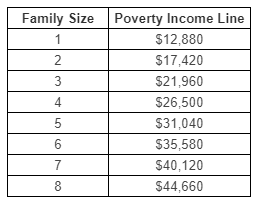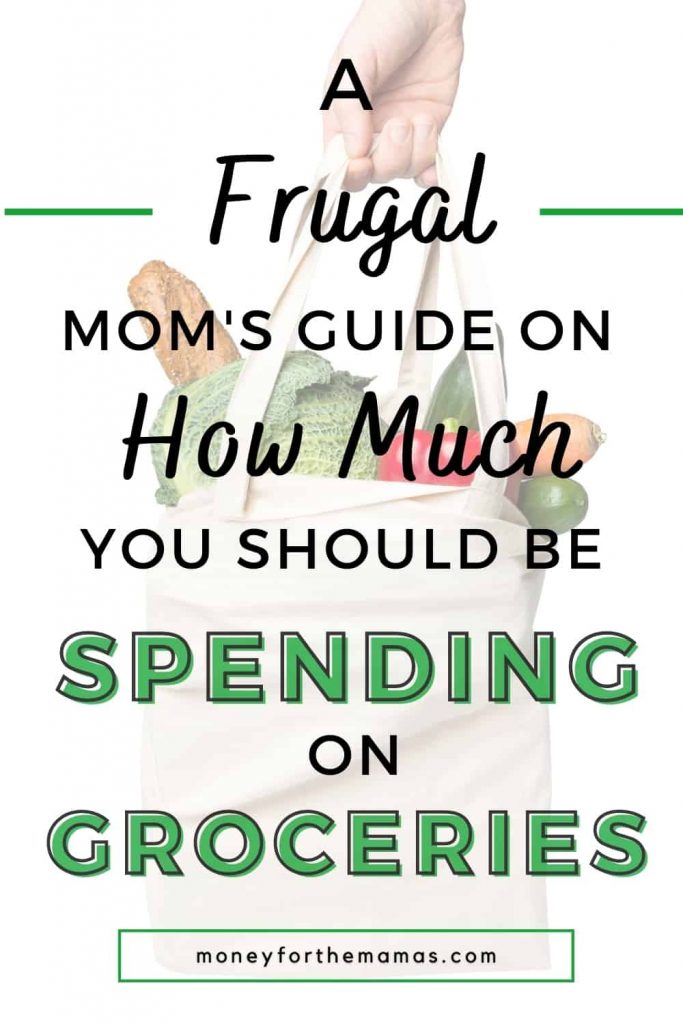How Much Should I be Spending on Groceries – a Frugal Mom’s Take
Here are the three official USDA grocery spending plans, and let’s see if they make sense for your family.

Author: Kari Lorz – Certified Financial Education Instructor
As a mom going grocery shopping, you need a plan of attack (you’re no newbie walking in without a list!). But still, as you walk the aisles, pick up what you want, and into the cart it goes.
You pay the cashier, load up, get inside your car, and look at your receipt total. Well, it’s less than last time, but you wonder, “How much should I be spending on groceries?”
You could be overspending (boo!), or you could be totally underspending (ya!). Let’s dig into what the experts say about how much you should be spending on groceries.

This post may contain affiliate links. If you make a purchase, I may make a commission at no cost to you. Please read my full disclosure for more info
The USDA Food Plan: The Cost of Food at Home
We’re getting as official as we can to get the info we need, the USDA. Every month they update this chart (see below for image) on the recommended food budget for American families. This doesn’t specify what portion of this budget is for groceries for the home or dining out at restaurants or fast food.
Being that it’s the US government and their access to average food cost vs. access to restaurant information, I will make an educated guess that they consider this graph to represent money spent on groceries for all meals.
I know we all don’t approve of the government; we may think they’re idiots or the shining light guiding us. I’m not here to debate it. I am just using their data. Could their numbers be out of touch? They might be. But it’s a great starting point for us to use today.
Their graph plots out food costs based on…
- Gender
- Age
- Meal plan type
- Thrifty plan
- Low-cost spending plan
- Moderate-cost spending plan
- Liberal plan

Now you might feel that you’re thrifty in your spending habits, yet this chart may not reflect that you’re in the low-cost category. This happens, “low-cost” or any other categories are very subjective, all based on a scale they made up.
For example, you might be thrifty, but due to your living location (i.e., HCOL), that may mean that you are spending in a higher spending plan for your overall monthly grocery bill.
When would this food budget be out of line?
If you find yourself living in an extreme area, this recommended spending on groceries wouldn’t be enough. For example, food desert areas are notorious for being very expensive, with little to show for it.
According to the Centers for Disease Control and Prevention (CDC), food deserts are “areas that lack access to affordable fruits, vegetables, whole grains, low-fat milk, and other foods that make up the full range of a healthy diet.”
These deserts are usually either extremely rural or impoverished inner-city areas. For example, a child’s only access to fresh fruit may be going to the corner convenience store, having the option of buying a 4-day old banana that costs $1, or all the prepacked shelf-stable snacks galore for $.65
The focus of this post isn’t to debate healthy food choices, but it’s important to acknowledge the problems that we as a whole American society face.
According to Forbes, In November of 2020, the US poverty rate rose to 11.7%. While the US Dept of Health & Human Services states that the poverty guidelines for families are…
We’ll take a look at how this matches up with the recommended spending on groceries below…

on poverty & income
Real-life grocery budget examples:
Let’s go through a typical family structure and my own, as I am curious about what my spending is considered. Honestly, I’m a little concerned; everybody has that thought, “Am I normal?”
How much should I be spending on groceries for a family of 4?
Let’s make a fictitious family…
- Mom & Dad, mid 30’s
- Son – 5yrs old
- Daughter – 3yrs old
The figures from the USDA only cover food shopping, not any health & beauty items, nor household goods (i.e., toilet paper, cleaners, etc.). So it might be a little hard to initially match up your spending if you shop for all of these items together.
We’ll break it down by person, and with an organic increase option, and then together as a whole family.

For a family of four, you’re spending on groceries should fall between $590 – $1,383 a month (in 2021), which seems like a wide range; this comes to be about $136 – $319 a week. The weekly figure seems a little more limiting.
NOTE: For the 2022 update, the range for a family of 4 is $875.10 at a low-cost plan – $1,287.40 at the liberal plan.
Remember, this is just groceries, not a dining-out budget. BUT, on the USDA’s chart, it doesn’t specify how many meals this covers, nor what percent is for dining out. Remember, we’re assuming it’s all groceries for all meals at home.
Grocery spending for families living in poverty:
We talked above about if the food guideline is appropriate and relevant in today’s society. Consider that 11.7% of Americans are living in poverty, let’s look at their food budget.
$26,500 annual income
$7,080 annual thrifty food budget for 4 people = 27% of their annual budget
While the recognized amount that people “should” spend on food, according to budget & debt pro-Dave Ramsey budget percentage is 10% – 15%. That’s a far cry to the “thrifty” food plan laid out by the USDA. So instead of spending $7,080, they should be paying only $2,650 – $3,975 on their groceries.
That’s a big disconnect; there’s no getting around the guidelines vs. reality just doesn’t match up. So either the USDA is out of touch in their grocery spending, or Dave Ramsey’s budget recommendations are off. Yet, many financial experts agree on the 10-15% for the average household grocery budget, but there is usually an additional category for “entertainment” that dining out could fit in under.

My family‘s recommend grocery budget per month
According to the USDA chart, my family should spend the following on groceries per month…

So we “should” fall between $482 – $1,138 a month.
NOTE: for updated 2022 numbers, we should fall between $724.90 – $1091.30 according to this updated chart.
I do 99% of the grocery shopping for our family. During a typical month, I shop at…
- Discount warehouse (Winco) for 60% of my shopping trips
- Big box store (Target) for about 25% of my groceries
- Regular grocery store (Kroger) for about 10% of my trips
- Specialty store (New Seasons Market) for 5% of my trips
I would say that I am a fairly frugal shopper in that I try and save money by planning before I go to the grocery store, and while I’m shopping I do have some tricks & tips up my sleeve! I worked in grocery for six years so I know how to save money at the grocery store, despite flashy marketing and product placement!
- I live & shop in a suburban area.
- Have a specific shopping list of items, and usually stay on track with the grocery list, maybe add 1-2 things that weren’t on the list into my cart.
- I like coupons (a lot) but haven’t used them a lot lately for food. Now I usually use them for health & beauty goods, which is outside the scope of this post.
- I meal plan with a focus on being budget-conscious.
- I am price-conscious. I frequently look at the price per ounce of an item and buy a larger/smaller size to get the more cost-effective deal.
- I may buy store brand items for about 20% of the things.
- I don’t buy a lot of meat. If I do, it’s smaller portions on the plate.
- I have about ten go-to frugal meals, and some deliciously dirt cheap meal options as well.
- Try to buy healthier food options, I limit frozen prepared meals, but we do like frozen pizza as an emergency meal option. We buy maybe 1-2 snack food items per trip, which would either be a bag of chips, a carton of ice cream, or snack crackers.
- If something is on sale, and it’s a great price, I will stock up.
- I buy organic milk and organic fruits & veg. (organic strawberries and raspberries are the death of my grocery budget!)
- I meal plan recipes that have inexpensive ingredients.
Those things being said, my monthly food budget is around $920. I give an approximate, as I buy household goods and health & beauty items in that figure.
For my actual spending, I am usually within my monthly food budget +/- $50. There might be a great sale on something, so I buy a lot of it (i.e., free-range chicken breasts at $2 off a lb, and I’ll buy 20 and freeze them).
Or maybe I was just out of it and wasn’t very on track with money that month. With everything in life, your attention wanes and flows for things. Some months I’m 150% on my budget, and other months I’m a little more relaxed.
According to the USDA chart, I fit in the moderate food budget spending plan while veering into the organic cost structure. I feel that’s fair. I save on some items and splurge on others which average to be “moderate.” If we added in the number of times we eat out (usually once a week we get to-go food from restaurants), we would be in the liberal category.
Crystal Paine’s eBook – Slash Your Grocery Bill is amazing! She blogged for years under the Money Saving Mom site.
The eBook goes over 25 ways to cut your grocery budget. From how to plan a menu on a budget, how to strategically shop, how to use digital couponing apps, and low-budget meal ideas.
Factors that influence how much you spend on groceries
I want to preface that there are a lot of things that influence your grocery bill. Some may affect it a lot, and some things may affect it only a little.
- Family size
- Age of family members
- How often you eat at home*
- Metro/Rural location
- Store type – discount warehouse, regular grocery store, convenience store, specialty market
- Store structure – large chain, independently owned, co-op
- Do you shop the sales?
- Do you use coupons?
- Do you meal plan?
- How often you grocery shop. Frequent trips = higher spending
- Do you buy convenience items – i.e., precut veggies, frozen pizza, etc.?
- Dietary restrictions – gluten-free, allergies, etc.
- Dietary preferences – keto, vegan, non-GMO, organic, etc
- Food preferences – does your family like grilled cheese sando’s, or do they like to eat expensive rib-eye steaks, etc.
- Food trends – trendy food costs more (i.e., keto)
*For the sake of this post, we’re only looking at food bought at the grocery store, not money spent on meals outside of the home.
- Sign up with ibotta and get $10 sign up cash as a new customer!
- Earn points on ANY receipt from ANY store and redeem for gift cards with the fetch rewards app.
- Sign up with Inbox Dollars and get paid to read emails, watch videos, and take surveys. Easy peasy!
- Get free gift cards & cash for the everyday things you do online at Swagbucks. Use the link and get a $5 bonus
- Save money on gas by signing up with Upside; it gives you up to $.25 cents cash back per gallon! Use the code AFF25 when you sign up; you’ll get a $.25 cents per gallon bonus!
- Sign up with Cash App and get a $5 bonus when you use code “NRTZMHV.” You have to complete the sign up requirements to get the bonus! Read how to do this here with point #1.
Are organic groceries a lot more expensive?
Since buying organic foods is the most popular dietary preference in America (if you even have a dietary preference), I want to dig into this one.
According to Marketwatch, “in 2019, organic food cost an average of 24 cents more per unit than conventional food, or about 7.5 percent more, according to Nielsen.” They continue that this is less of an increase than previous years and that within the organic sector, there is a wide range of increases depending on the category (i.e., produce vs. dairy).
While ConsumerReports says, it costs on average 47% more to buy organic.
While according to HowStuffWorks, they report that the USDA says it costs 10% – 30% more than conventional foods. I couldn’t find a direct link to the USDA site, but since we’re using the USDA Food Budget, let’s go with the middle of the road at 20%.
If your family eats organic (or has another eating restriction/dietary need), we’re going to take your total food spending allowed (according to the chart below) and then add 20%. This could be a good starting increase for any dietary restriction or diet preference.
For my own family I buy some organics, but not all. I buy OG for the dirty dozen fruits & veg and for dairy. I try and purchase only pasture-raised eggs, and I would like to buy only OG meats, but it’s usually too expensive. If you would like to try organics, definitely start with the dirty dozen items.
Why do organic foods cost more?
I worked in a specialty grocery store for six years; it sold both convention food (i.e., Oreos) and all of the fancy organic, non-GMO, fair trade, imported, etc. So I feel pretty confident in this.
- It costs quite a bit for an organization/farm to be certified organic.
- Organic farms save money on pesticides but spend more on labor to weed and do insect control.
- Conventional foods are typically made from cheaper ingredients.
- Conventional foods are made by larger corporations that have already established business structures, corporate funding, and distribution centers.
- Organics benefit from the supply & demand scale. There’s more demand usually than food available, which increases prices stores can sell it for.
- Higher standards for animal welfare cost more (more land space, more barns, more laborers, more expensive feed, etc.).
What about food cost and inflation?
The Balance reported that “Since the beginning of the 21st century, food prices have risen between 2.0% and 3.0% a year on average. Grocery store prices have risen 2.0% while restaurant food prices have increased 2.8%.”
So nothing out of the extraordinary here with inflation. Yet the percent of disposable income that we spend on food has decreased over the decades.
Back in 1900, families spent about 40% of their income on food. By 1950, it was just under 30%. According to the most recent data from the U.S. Bureau of Labor Statistics, in 2013 the average American household spent about 10% of its total budget on food cost; according to ValuePenguin.
If you want to know exactly how much grocery gurus think you should spend then check out Erin Chase’s Grocery Spending Formula in her free Grocery Savings Workshop!
At the end of the day
Although this isn’t news to me, I find it comforting to know that my budgeting and spending are in line with “normal” average family. There’s something satisfying about being average (in some areas of your life). Will this change my grocery shopping habits? No, it won’t.
So ask yourself, “How much should I be spending on groceries?”
The answer is whatever it takes to get your family the food they need to live happy & healthy lives! Yes, by all means, pay attention to the guidelines, but don’t let them rule your life. You’re the mama, and you’re in charge! Just don’t go to the grocery store hungry! 🙂
Articles related to how much you should be spending on groceries:
- Frugal Mom’s Guide to Meal Planning
- How to Save Money at the Grocery Store BEFORE You Shop
- 20 Smart Tips to Help You Nail Grocery Shopping on a Budget
- 50 Deliciously Dirt Cheap Meals
- Saving Money Like a MOM with the Cheapest Grocery List Possible!









I haven’t seen the USDA chart in years. Thanks it was helpful and makes me feel better about what I’ve been spending actually! It’s not as much as it felt like it was.
Jenn, I am so glad that the USDA chart was helpful for you and made you feel better about your spending. Knowing “norms” is very helpful (for me at least), and I use it as a starting place for my own spending/habits. Of course, adjust as you need to for things out of your control (HCOL vs. LCOL, urban vs. rural, etc).
These tips will help a lot of people!
I’d add that buying meat in bulk will save you a lot of money in the long run. Up front it may be expensive to pay for a side of beef or a whole hog, but you will feel the savings when you don’t need to buy meat for a year!
Yes, buying from a local farmer is a great way to buy meat at a discounted price per lb, even though it’s expensive up front, it’s so nice never having to go and shop for meat and worrying about the prices!
Great list! I’ve been making our own yogurt (in my slow cooker) this year and went bake to baking our own bread. It does save us so much money! I’d add maintaining a stockpile. When I can find pasta at $0.50 a box (or less), I’m going to buy enough boxes to last me for a couple months. Or a great deal on peanut butter…or whatever it may be. It takes a bit of intention but a stockpile saves our family so much money!
I too buy a bunch of something when it goes on a great sale. You’ll find that most products go on sale every 6 weeks on so, it maybe different sale prices but it’s a discount at least. When buying multiples I always look for coupons so I can double dip on the savings!
Organic food seems to be a bit more expensive in the UK than in the USA, but I would always pay the extra. I only wish I had a guarantee that is 100% organic, which I don’t always have. I keep hearing stories from people who worked on production lines and how only the packaging was different for a sack of carrots picked from the same plot – what looked better was branded as “organic”
Yikes! Hearing that would be alarming! From my experience, the USDA organic certification is highly regulated, but I know that things change over time, and geographically.
I love the depth of which you have gone to share just how much something so simple can and does cost. Even more, I like that you share how it looks for different family sizes and what to strive for! Thank you for this post very insightful!
Thanks so much for the kudos! So glad you liked it!
this is great, I find some organic veggies cheaper or just the same price here somehow. This gives me an idea to really dig in my grocery spending habits.
So glad you have some good priced OG options! Maybe due to seasonality? I dunno, but that’s great!
Thanks for all the details and research in this post. Lots of great, new ideas for eating healthy while trying to stick to a budget. We also buy organic for the dirty dozen but not for everything.
Yeah, the dirty dozen list is a great place to focus your dollars if you’d like to limit pesticide exposure!
Thank you for your comprehensive article about purchasing groceries. Your examples, charts, and data were helpful too!
So glad you liked it Rose, thanks for stopping by!
So much good information on budgeting for grocery shopping. Having a list is crucial and yet I still find myself straying from the list…ugh! I really love the online coupons that many stores offer as well….huge help! Meal planning…I see so many posts on this and it is something I need to improve upon as well. This detailed post is so helpful…thanks!
So glad you like the post! I too go off track with my list, but I always make it a point to hand 1-2 things back to the cashier during checkout 🙂 I save a lot this way!
Depending on what we need at the time we average between $180 to $300/week here in Canada. I always meal plan and we do not eat a lot of prepared foods. I remember the sticker shock for groceries, when we moved back to Canada, from the U.S. Such a difference!
Yeah, grocery sticker shock is not a pretty sight, and I didn’t realize there was such a large difference between the US & Canada pricing on food.